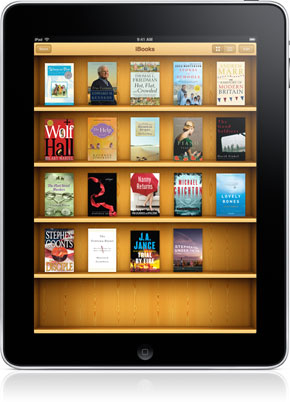Appliance Shakeout
by Egatz
Much has happened in the world of e-books this past month. In the face of iPad juggernaut, Amazon.com has been forced to accept reality. The Kindle’s price has been brought more in line with it’s abilities compared to the full-functionality of the iPad. With the Kindle down to $189 from $259, and the Wi-Fi-only version reduced more than $100 in a single day, Jeff Bezos and crew understand what happens when a singular-use device faces a computer. Humans are visual creatures, and it might be worth reminding at this point the Kindle is essentially a singular-use device with a black and white display.
E Ink technology is impressive, but throwing a few hundred dollars more for a device you can watch movies on creates a serious problem for Amazon. Throw in email, Web browsing, writing, and early versions of rich media e-magazines and books, and the playing field is drastically altered compared to the beginning of the year. Throw in 200,000 applications, and it’s game over in the minds of many consumers.
As Amazon attempts to remind readers their content can be used on the iPhone, iPad, and even Mac via their Kindle app, it begs the question of what’s a Kindle worth. It wasn’t long ago cellular carriers gave away hardware to entice subscribers to sign-up for years-long contracts at insane prices. My first mobile phone service ran me $65 a month for 45 minutes of service in 1994, and I got a free phone. Yes, those numbers are accurate. Thanks, NYNEX! Anyone remember NYNEX? For me, what the Kindle—a one-trick pony—is worth is about fifty bucks. I could see paying an absolute maximum of fifty bucks for an e-book reader tied to a business that’s going to reap an ongoing revenue stream from my book habit.
Barnes and Noble is still in the game with their Nook, which runs either $150 or $200. Some engineers and even more marketing poltroons thought building a device with two displays was a good idea. It’s not. Trying to be the best of both worlds without the full-functionality of a computer, the Nook uses E Ink for book reading, and a 3.5-inch color touch screen for everything else, which isn’t all that much. Len Riggio and cohorts actually did get a few things right with Nook. You can connect to Wi-Fi networks in Barnes & Noble stores and browse entire e-books before purchasing, just like the dead tree versions. Makes sense. You can also lend e-books for up to 14 days, which is another cool move. I’ve learned my lesson on lending out dead tree books, but if I let someone borrow an e-book, in theory it defaults back to me in a fortnight. Good job, Lenny, but I’m still waiting for you to respond to the letter I wrote you in 1993. Barnes and Noble has shown the bigger players that if you’re coming to market with a lesser-device, you can innovate on the sales model and pricing (500,000 out of 1.5 million e-books for the Nook are free).
Borders is also in the game, with the Kobo, at $150, covered here.
In last place is Spring Design’s Alex. Way out of step with a price of $400, Alex suffers from the Nook’s approach of dual screens, making it a sloppy, almost nine inches tall. Didn’t anyone tell the engineers at Spring Design what the dimensions of an actual book are? How about a typical book?
Do readers want an oddly-shaped device to read their books—a shape unlike the dimensions of books they’ve lived their whole lives reading? I think not. Do they want a dual-display device so they can look at bookcovers in color? Probably not. Do they want a singular-use device, with a few extras ungainly and awkwardly thrown in, such as the ability to use Twitter? Not really. The problem to these approaches is the hardware and the pricing. Apple has been doing software with incredible user interfaces since the Lisa. They are here to eat other hardware for breakfast. If they provide a third of the e-books Amazon does, they will be successful. They sold 2 million iPads in less than the first sixty days of the device being available. They sold 3 million by mid-June. These numbers will progress geometrically as availability is rolled out in other countries.
As we see the old warhorse iPod effectively being phased out, the writing is on the wall for hardware designers of e-book readers. In 2007, the iPod became obsolete as music listening functionality was folded into the iPhone. If you don’t want to be sodomized by AT&T each month, the iPod Touch is still selling like hotcakes. Not only does it offer iPod functionality, but there’s those undeniable 200,000 applications at the ready. It’s a miracle the Great and Powerful Jobs hasn’t killed the other iPods off already.
Publishers are scrambling for a business model, and I have an answer, but only on a consulting basis. I will share this, however. The answer isn’t in the hardware any longer. As Steven Crane wrote, “That much is certainly true.”

Comments
[…] iPad trounces Amazon’s Kindle in users’ reading speeds. I’ve made it no secret I wouldn’t pay more than fifty bucks for the Kindle, a one-trick black and white pony with a […]